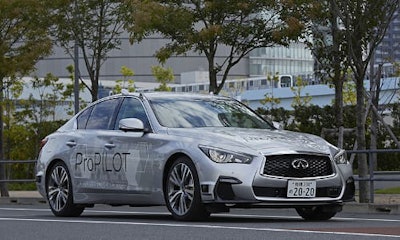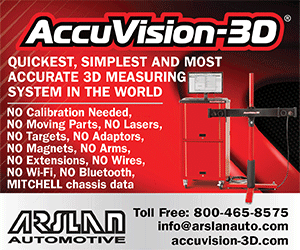
By Jeff Sanford
Toronto, Ontario — October 26, 2017 — In this week’s Autonomous Report, we look at the rise of military autonomous vehicles (AVs), Nissan plans an AV launch for 2020, Magna partners with Mercedes, disruption on the construction site, and much, much more!
-A report from Ukraine notes that officials there indicate, “… they are planning to use armed ground robots in their conflict against Russian-backed forces next year.” The report goes on to say that on October 9, Ukrainian military and defence leaders demonstrated the robot. The Phantom was developed by a Ukrainian defence contractor. It can hit speeds of up to 37 mph and can go 81 miles on one engine charge. “It can have treads like a tank or six wheels and be armed with anti-tank weapons, grenade launchers or machine guns,” according to a report in Defence One magazine. The attack-bot has a backup microwave-communication link so that the operator can communicate with the device if it is hacked or jammed. This is a consideration as Ukrainian troops already encountered military-directed hack attacks in action against Russian-backed troops.
– Nissan has demonstrated a prototype of its most advanced autonomous vehicle, and announced that it plans to launch the car for real-world use in 2020. The company tested the next generation ProPILOT technology on a modified INFINITI Q50 sports sedan on public roads in Tokyo. The prototype’s artificial intelligence (AI) uses input from 12 sonars, 12 cameras, nine millimetre-wave radars, six laser scanners and a high-definition map to analyze complex scenarios in real time and navigate smoothly through challenging city conditions – such as crossing busy intersections. The technology enables the vehicle to operate autonomously on urban roads and freeways beginning when the driver selects a destination using the navigation system, until arrival.
– The expansion of ride-hailing services like Uber and Lyft are having an impact on transportation usage. A study from the UC Davis Institute of Transportation Studies found the explosion in popularity of ride-sharing apps has, “… caused a slight decrease in car ownership — but has also reduced use of public transit, biking and walking.” The study also found that there likely has been an increase, “… in both traffic and the number of miles travelled in a vehicle.” Some proponents of AVs predicted that ride-sharing models combined with driverless tech will reduce congestion in urban areas. This finding seems to suggest what others predict: That simplified, efficient, cheap car access will see roads jammed with people. If the cost per ride falls in the AV era of ride sharing, the total number of miles that people will move will increase. This an example of Jevon’s Paradox. William Stanley Jevons was an 18th Century economist known today for elucidating many of the basic ideas of microeconomics. Jevons also wrote a book, The Coal Question, which asked (and tried to answer) the key questions underpinning the Industrial Revolution he was living through: How much coal is there? How much of this finite substance do we have? Thinking about energy and how humans consume it, Jevons came up with his paradox.
He postulated that whenever more efficient and energy-saving devices are introduced into the economy, total energy consumptions tends to rise. Optimistic commentators on economics often argue that, say, climate change goals, can be achieved by making more energy efficient products. Jevons understood that by making products cheaper and more efficient, they become more available. People tend to use the new efficient devices in great numbers. Think of it this way: Many say the introduction of LEDs into the economy will see vast reductions in the amount of electricity used. Jevons would say that as more cost-efficient method of lighting becomes available, LEDs will be bought and installed in greater amounts. So many will end up being used that total energy consumption actually rises. One of the academics involved in the study was quoted as saying, “Although we found that ride-hailing can be complementary to transit and reduce vehicle ownership for a small portion of individuals, we found that (overall) these services currently facilitate a shift away from more sustainable modes towards low occupancy vehicles in major cities.”
The authors of the report also said, “Ride-hailing is currently likely to contribute to growth in vehicle miles traveled in the major cities represented in this study.” As a result, “Given that likelihood, policymakers should consider giving priority to high-occupancy vehicles through methods such as congestion pricing and priority lanes.”
Some of the other findings include:
- “Urban Americans use ride-hailing much more than those in the suburbs. While 29 percent of city dwellers surveyed use Uber and Lyft, only 7 percent of suburban respondents do so in their hometown. Another 7 percent of suburbanites use the services when they travel elsewhere.”
- “Almost a quarter (24 percent) of ride-hailing passengers use the services daily or weekly.”
- “Parking is passengers’ top motivation for hopping into an Uber or Lyft rather than driving, with 37 percent citing this. Avoiding drinking and driving was cited by 33 percent.”
- “Usage is more prevalent among younger people. Among those 18 to 29, some 36 percent use ride-hailing compared with only 4 percent among those age 65 and older.”
- “The vast majority (91 percent) of ride-hailing customers say it has not changed whether or not they own a vehicle.”
- “Riders who now drive less often said they instead use ride-hailing for those trips. The report said it wasn’t possible to determine changes in net vehicle miles traveled.”
- “Urban ride-hailing passengers decreased their use of public transit by 6 percent. Bus and light rail service were both used less often by Uber and Lyft riders, while commuter rail saw a 3 percent bump in usage.”
- “Many ride-hailed trips (49 to 61 percent) would have not been made or would have occurred via walking, biking or transit.”
The data collected in the study was acquired through various means. Uber and Lyft would have extensive amounts of data on customer usage patterns. But the companies wouldn’t release that. The city of San Francisco has gone to court, “… to demand information from the companies about their use of city streets.” It is interesting to note that Toronto Transit Commission (TTC) seemed to be at a loss earlier this year to explain a sudden, unexpected stall in growth ridership. The TTC had predicted that as more people move to downtown Toronto ridership rates on public transportation would continue to rise. That has not been the case. The stall in ridership numbers seemed to occur correlatively to the emergence of ride-sharing apps in the city.
– A report on the tech website Arstechnica.com tells the story of a firm that had hoped to compete with Google and Apple on smartphone operating systems. The company, Cyanogen, had come up with an open-source operating system for Android devices. The firm even had the OS installed on 50 million smartphones. But executives realized they were not going to be able to compete. After a couple of bad deals the company fired most of its staff and closing the Seattle office. The company reassessed market opportunities and is back. Now named Cyngn, the organization is looking to provide AV tech for machines, such as those used on a construction site.
According to the report the company is still in stealth mode, but it is said that the executives and board members at Cyngn see, “… automated vehicles as being as disruptive in the next five years as smartphones have been over the last decade. Cyngn is now back up to around 30 staff, including autonomous automotive engineers from Mercedes Benz and Udacity, according to LinkedIn, and is still on a hiring spree … In late September, Cyngn received a permit to test two autonomous vehicles in California … A document prepared for a South Korean trade delegation to Silicon Valley in May reveals that Cyngn is planning to convert loaders, excavators and other construction vehicles to become fully autonomous.” This could be a lucrative space. Eventually the original blueprints prepared for the construction of a building could be read by machines, which then self-organize to carry out necessary tasks. The humans on site would be there primarily to monitor the machines, and schedule processes. According to the story, “Job listings on Glassdoor show that Cyngn is working with radar, camera, ultrasonic, and LiDAR sensors, and using ROS, an open-source operating system for robots.” Sprinkle on some deep learning and AI … and the future of the construction industry begins to come into focus. The company has attracted venture funding from some of the biggest names in Silicon Valley, including Andreessen Horowitz, Qualcomm Ventures, Foxconn and Tencent.
– GM has been said by analysts to be the domestic auto maker that has moved the fastest into the AV sector. Proof of the new Silicon Valley-like speed with which the company is moving is the recent acquisition of a company named Strobe. Accord to a press release, “Our acquisition of Strobe is a significant step toward our mission to deploy self-driving cars at scale. The founders, Julie Schoenfeld and Dr. Lute Maleki, and their team bring decades of sensor development experience to Cruise. Strobe, Cruise, and GM engineers will work side by side along with our optics and fabrication experts at HRL (formerly Hughes Research Labs), the GM skunkworks-like division that invented the world’s first laser. Together we’ll significantly reduce the time needed to create a safer and more affordable form of transportation and deploy it at scale.” GM is ready to move at start-up speed. What a radical new image for the company that once defined old school hierarchy and plodding decision-making. The release goes on to say that the acquisition is an important part of solving what GM calls “the LiDAR problem.”
According to the release, “Sensors are a critical enabler for deploying self-driving cars at scale, and LiDARs (sensors that use laser light to measure the distance to objects) are currently the bottleneck. Existing commercially available solutions cost tens of thousands of dollars, are bulky and mechanically complex, and lack the performance needed to unlock self-driving operation at higher speeds and in more challenging weather… To solve these problems we’ve acquired Strobe, a company that has quietly been building the leading next-generation LiDAR sensors. Strobe’s new chip-scale LIDAR technology will significantly enhance the capabilities of our self-driving cars. But perhaps more importantly, by collapsing the entire sensor down to a single chip, we’ll reduce the cost of each LIDAR on our self-driving cars by 99 percent.”
Some auto analysts have suggested that the introduction of AVs onto North American roads will have to involve a ridesharing model, as individual AVs will be too expensive for the average person to afford. GM seems to hope that it’s new acquisition will be key to reducing the cost of an AV. According to a press release, “As the cost of our self-driving vehicles declines, we’ll be able to accelerate the rate of vehicle production and more quickly roll out our technology to suburban and rural areas where ride sharing is less common today.” Elon Musk has been criticized for promoting his cars as self-driving, even though they don’t have LIDAR. Tesla’s rely only on sensors for situational awareness on the part of the vehicle.
Many in the industry think LiDAR will be key for safety reasons. LiDAR sensors contribute to the redundancy and overlapping capabilities needed to build a car that operates without a driver, even in the most challenging environments. Our new sensors are robust to interference from sunlight, even in extreme cases, which means they can continue to operate in situations where camera-based solutions fail. When the sun is low in the sky and reflects off wet pavement, camera systems (and humans) are almost completely blinded. And when a person in all black is walking on black pavement at night, even the human eye has trouble spotting them soon enough: Strobe’s LiDAR sensors provide both accurate distance and velocity information, which can be checked against similar information from a RADAR sensor for redundancy. RADARs typically also provide distance and velocity information and operate under more challenging weather conditions, but they lack the angular resolution needed to make certain critical maneuvers at speed. When used together, cameras, LiDARs, and RADARs can complement each other to create a robust and fault-tolerant sensing suite that operates in a wide range of environmental and lighting conditions.” This is the future. Cars have the kind of devices that used to only be on helicopters, ships and airplanes.
– Other companies hustling to get their AV strategy together include the BMW Group, Intel and Ontario-based auto parts maker, Magna, which has signed on to help, “… industrialize and customize the domain controller designed by BMW Group, Intel and [chip maker] Mobileye.”
Magna’s Chief Technology Officer was quoted in a press release as saying, “Many of the autonomy challenges the industry is facing can’t be handled in isolation. I am confident that the many strengths brought forward by each partner will contribute to the delivery of a self-driving platform the market can leverage. We are extremely excited to be one of the early integrators bringing our unique capabilities to the platform.” The release goes on to state that, “Through this collaboration, the BMW Group, Intel and Mobileye plan to provide an autonomous vehicle platform that can be flexible and adoptable for integration by multiple automakers.”





















